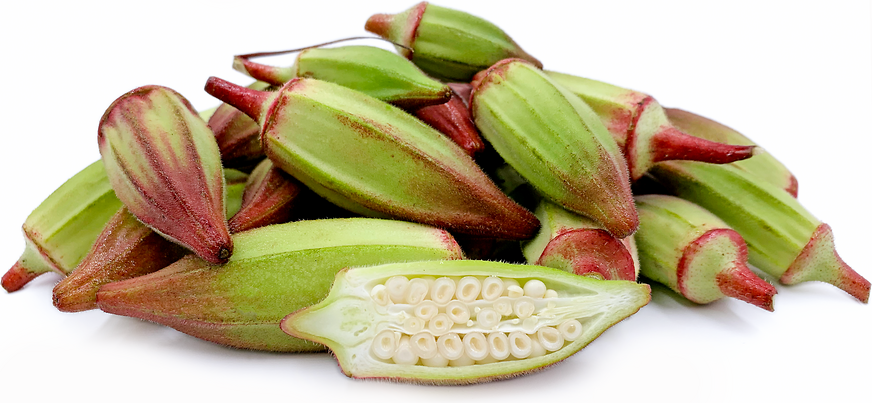


Alabama Red Okra
Estimated Inventory, lb : 0
Description/Taste
Alabama Red okra consists of small, elongated pods, averaging 10 to 15 centimeters in length and 2 to 5 centimeters in diameter, and has a bulbous, cylindrical to block-like shape, tapering at the non-stem end. The pods are firm, smooth, and angular with defined ridges and are sometimes covered in a fine layer of hair or spines. The pod's surface also showcases the variety’s unique coloring, being mostly green with crimson to bright red accents. Like the pods, the stems and leaf veining of the plant showcase dark red hues, visually distinguishing it from other okra cultivars that are mostly green. Underneath the surface, the flesh is pale green, crisp, and thin, containing mucilage, which gives the pod a slick mouthfeel. In the pod's center, there is also a central cavity filled with many cream-colored to white oval seeds. These seeds contribute to the pod’s crunchy and slightly spongy consistency when raw. Alabama Red okra is traditionally harvested before full maturity and has a subtly sweet, nutty, and vegetal flavor.
Seasons/Availability
Alabama Red okra is available year-round in warm climates, with a peak season in the late summer through early fall.
Current Facts
Alabama Red okra, botanically classified as Abelmoschus esculentus, is an heirloom variety belonging to the Malvaceae family. The thick, bi-colored pods are a favored home garden cultivar and are used as an ingredient in culinary dishes throughout the Southern United States. Alabama Red okra is not commercially grown on a wide scale and is primarily found in backyard gardens, favored by growers for its easy-to-cultivate, prolific nature, rarity, and large plant size, reaching up to two meters in height. The plants will produce many edible pods throughout the season, and the young and tender pods are utilized in a wide array of fresh and cooked culinary preparations.
Nutritional Value
Alabama Red okra is an excellent source of vitamin K to assist in faster wound healing and vitamin C to strengthen the immune system. The pods are also a good source of manganese to construct connective tissues, folate to produce healthy red blood cells, and contain lower amounts of potassium, phosphorus, zinc, iron, copper, magnesium, and calcium.
Applications
Alabama Red okra has a sweet, subtly nutty flavor well suited for both raw and cooked applications. The pods can be harvested young, utilized fresh in salads, or they can be sliced in half, sprinkled with salt and pepper, and eaten as a fresh appetizer or snack. Alabama Red okra can also be grilled, fried, boiled, steamed, or stir-fried, and the pods will turn bright green when cooked. The pods can be lightly steamed, coated in butter and salt, and served as a simple side dish, sliced and tossed into soups and stews, or cut and layered into ratatouille and casseroles. They can also be rolled in cornmeal and fried, chopped with other summer vegetables and baked into a pie, pickled and canned for extended use, or stir-fried for a crisp texture. It is important to note that the cooking method and the addition of acidic ingredients such as tomatoes will help to reduce okra’s slimy consistency. In the Southern United States, Alabama Red okra is popularly cooked into gumbo, a thick stew made from flavorful spices, meats, and vegetables, often spooned over rice. Alabama Red okra pairs well with tomatoes or tomato sauces, corn, eggplant, bell peppers, legumes, herbs such as oregano, basil, parsley, and thyme, garlic, vinegar, meats including beef, pork, and lamb, shrimp, and spices such as turmeric, coriander, garam masala, paprika, and chile powder. Unwashed, whole Alabama Red okra pods will keep 2 to 3 days when loosely wrapped and stored in a perforated plastic bag and kept in the refrigerator’s crisper drawer. The pods can also be blanched and stored in a plastic bag in the freezer for 2 to 3 months.
Ethnic/Cultural Info
Alabama Red okra is a favored variety featured in the Okra Festival in Lowndes County, Alabama. The annual summer festival was established in the early 21st century and was created as a neighborhood gathering celebrating culture, food, and music. Okra was a central ingredient in the celebration as it was a common vegetable grown throughout the neighborhood’s home gardens and was one of the only thriving plants found during hot summer months. In the modern-day, the Okra Festival has grown beyond a small gathering to one of the most popular events held in Alabama in the later summer. Thousands of visitors attend the free event to listen to live music, sample local cooking, and support local artists and artisans. At the festival, vendors popularly sell dishes such as fried okra, pickled okra, or they sell the pods fresh by the bag. Okra is also famously cooked by local chefs into gumbo and is baked into okra pies, which are reported to sell out each year early in the morning.
Geography/History
Alabama Red okra is an heirloom variety that is a descendant of ancient okra varieties native to Africa. Okra was first discovered in a region spanning Ethiopia, Eritrea, and Sudan and was believed to have been cultivated since the 12th century BCE. The plants were later spread through Northern Africa into Europe, the Middle East, and Asia. In the 17th century, okra was brought from Africa to the Southern United States, where many different varieties, including Alabama Red okra, were bred over time. Today Alabama Red okra can be grown in tropical, subtropical to warm, temperate climates. The variety is primarily sold in seed form through online retailers, but fresh pods can also be found through home gardens, local farmer’s markets, and specialty grocers.
Recipe Ideas
Recipes that include Alabama Red Okra. One




